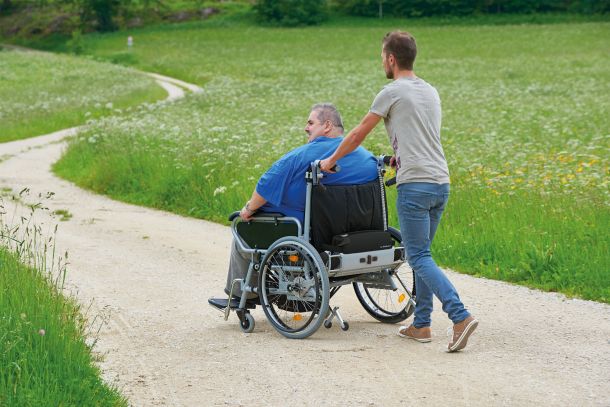
What is a push and brake aid for wheelchairs?
A pushing and braking aid for wheelchairs is a useful aid that makes it easier to use a wheelchair. It provides support when pushing the wheelchair, especially on uneven surfaces or inclines. In addition, the braking aid ensures that the wheelchair can be stopped safely, even on sloping surfaces or steeper gradients.
A pushing and braking aid is often used with special handles that enable better operation and control of the wheelchair. The wheelchair is propelled by a motor, the aim of which is to improve the mobility of the wheelchair user and their companion.
Why is a pushing and braking aid useful?
A pushing and braking aid is particularly useful for relieving the burden on the accompanying person. The range of movement is increased as longer distances can be covered without burdening the accompanying person. The risk of shoulder and back injuries, which can be caused by repeatedly pushing a wheelchair, is minimized. This makes longer trips with family or friends possible again.
Whether inclines, declines or uneven surfaces, these obstacles are no problem with a pushing and braking aid. Ramps and ramps can also be negotiated more easily, which contributes to increased driving safety.
After all, a push and brake aid also offers greater flexibility than a large power wheelchair, as it can be added or removed as required.
Areas of application for pushing and braking aids
The electric pushing and braking aid for wheelchairs is used in various areas. It is particularly useful in health and care facilities, where it assists care staff with patient mobility. It can also be useful in rehabilitation after injury or surgery by facilitating the transition to regaining independence.
In addition, it is used in public facilities such as schools, universities and shopping centers to ensure accessibility. Finally, the electric pushing aid can also be useful in private households to facilitate the mobility of family members with limited mobility.

Different types of pushing and braking aids
There are many types of pushing and braking aids for wheelchairs. An auxiliary drive, for example, can be a good option. This is fitted using a bracket that is attached to the lower part of the backrest. The drive of the pushing and braking aid can then be easily engaged or disengaged with one hand. The drive is equipped with drive shafts that drive the wheelchair wheels via sprockets. The wheelchair is controlled via control handles that are attached directly to the wheelchair handles.
Special XXL solutions are available for users with obesity. These are robust and can carry the increased weight. Particularly in the higher weight range, it is important to provide electrical support for the person pushing and braking the wheelchair.
Tips for choosing the right pushing and braking aid
Choosing the right push and braking aid requires careful advice. A test ride is important first to ensure that you are comfortable with the chosen model. Pay attention to the performance and battery type to ensure a longer service life. The design should not only be aesthetically pleasing, but also functional.
The weight of the pushing aid is crucial for transportation in the car. Flexibility and adjustability are other aspects that should be considered to allow for customization. Rely not only on the manufacturer's service, but also on the safety of the product. Remember that the right pushing and braking aid can significantly improve your quality of life.
Recommendations for the use of a push and brake aid
When using a pushing and braking aid, it is important to read the operating instructions thoroughly and to follow the manufacturer's instructions carefully. To avoid overloading the device, you should observe the technical data. The battery should also be charged regularly. It is advisable to allow only trained persons to operate the appliance.
The appliance should be cleaned carefully and with mild detergents to ensure its longevity. Remember that correct handling and care contribute significantly to the safety and efficiency of your pushing and braking aid.
If you have any questions regarding use or possible problems, you can contact your medical supply store or ask the manufacturer directly.
Where can a pushing and braking aid be purchased?
The first step before applying for an aid is a personal and individual consultation. Many manufacturers also offer an on-site service and will visit you at home. You should try out the various drive models in a familiar environment and select the model that best meets your requirements and needs.
To apply for the selected pushing and braking aid, you will then need to make an appointment with your doctor. Your doctor will check whether such an aid is necessary and, if necessary, issue you with a prescription. This prescription should always include the product name of the product that you have selected and already tested extensively.
You can then use this prescription to contact a medical supply store in your area. They will contact the manufacturer of the pushing and braking aid and also send a cost estimate to your health insurance company. Most wheelchair drives have an official aid number. The cost of the aid is therefore usually covered by your health insurance company and once it has been approved, the desired aid will be ordered and delivered to you as quickly as possible.
Frequently asked questions (FAQs)
Will my health insurance cover the costs of a pushing and braking aid?
In most cases yes, but this depends very much on the individual situation of the applicant and the specific guidelines of the health insurance company.
Is a pushing and braking aid classified as a medical device?
Yes, a pushing and braking aid is indeed a medical device, as it is used to promote and maintain the health and well-being of individuals.
Is my wheelchair suitable for a push and brake aid?
As a rule, pushing and braking aids can be attached to most common manual wheelchair models. Your medical supply retailer will check with the manufacturer of your pushing and braking aid to see whether your wheelchair model is compatible.




